August 2004 archives
August 1, 2004
Rack welding schedule
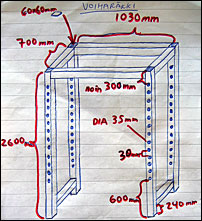 Our summer cottage neighbor, the one with the construction company, came over as agreed. He will have one of his guys weld the rack soonish. The hourly rate is 24 euro excluding tax and the job is estimated to take about four hours. I left the welder exact plans of the rack, its hooks and the bench. Once the rack has been welded, I will return to paint it and, hopefully, put the rack into place. There is a big boulder trying to prevent me from putting the rack where I want it, so will either need to do some rock demolishing, move the rack or call Steve Jeck. I actually have a demolition license, an inheritance from my compulsory service in the Finnish army as a field engineer sergeant, but don’t think I will dynamite it although it would be a blast.
Our summer cottage neighbor, the one with the construction company, came over as agreed. He will have one of his guys weld the rack soonish. The hourly rate is 24 euro excluding tax and the job is estimated to take about four hours. I left the welder exact plans of the rack, its hooks and the bench. Once the rack has been welded, I will return to paint it and, hopefully, put the rack into place. There is a big boulder trying to prevent me from putting the rack where I want it, so will either need to do some rock demolishing, move the rack or call Steve Jeck. I actually have a demolition license, an inheritance from my compulsory service in the Finnish army as a field engineer sergeant, but don’t think I will dynamite it although it would be a blast.
August 2, 2004
First Blakley bench day
With no soreness in the way, I finally had a first go at the main bench day of the Blakley bench program that I embarked on two weeks ago. After the pattern warm-up - a fancy way of saying that you always warm-up with the same weight pattern to prepare both mind and body - I did the required singles. Although 90 kg is doable in perfect form, I should probably drop back a little to keep me under 90% of max to avoid overtraining of the central nervous system. Then came the actual work sets, i.e. aiming for 4x6 with the same weight. I setup too close on the first set, with the result that I kept banging into the uprights. Otherwise the sets went well, but it is clear that I still have some work to do with 77.5 kg/171 lbs before I get a clean hand. Note that the bar is paused on the chest on every rep.
Bench pattern warm-up:
10 @ 20 kg/44 lbs
6 @ 40 kg/88 lbs
6 @ 50 kg/111 lbs
6 @ 60 kg/133 lbs
2 @ 70 kg/155 lbs
2 @ 80 kg/177 lbs
Heavy bench singles, paused: 2x1 @ 90 kg/199 lbs
Bench, paused: 5,5,4,3 @ 77.5 kg/171 lbs
One-handed dumbell row: 3x10 @ 34 kg/75 lbs
Side raise, kneeling on stability ball: 2x15 @ 10 kg/22 lbs
Seated cable reverse wrist curl:
6,4 @ 45 kg/99 lbs
6 @ 40 kg/88 lbs
8 @ 30 kg/66 lbs
Dumbell end holds: some 10 sets working down from 15 kg/33 lbs
Total training time: 60 min
August 4, 2004
Makeshift GHR with band assist
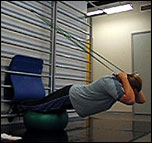 In the pile of mail that greeted us as we returned back to Helsinki on Sunday were the long-awaited mini bands. To my delight, the package also contained the EliteFTS Dynamic Squat manual, containing 29 squatting cycles ranging from the novice Rookie cycle to Paul Childress’s highly advanced squat progression cycle, and the EliteFTS Training with Bands leaflet that over thirteen pages touches on the theory behind bands, how to attach bands and a little something on basic band training. Training with Bands is rather general, but has some valuable info on how to clamp a 2x4 to the base of the rack to ensure that there is enough tension off the bottom. Dynamic Squat manual is a gold mine; never before have I seen so many cycles in one place. Will be consulting this one as soon as I get back to box squatting.
In the pile of mail that greeted us as we returned back to Helsinki on Sunday were the long-awaited mini bands. To my delight, the package also contained the EliteFTS Dynamic Squat manual, containing 29 squatting cycles ranging from the novice Rookie cycle to Paul Childress’s highly advanced squat progression cycle, and the EliteFTS Training with Bands leaflet that over thirteen pages touches on the theory behind bands, how to attach bands and a little something on basic band training. Training with Bands is rather general, but has some valuable info on how to clamp a 2x4 to the base of the rack to ensure that there is enough tension off the bottom. Dynamic Squat manual is a gold mine; never before have I seen so many cycles in one place. Will be consulting this one as soon as I get back to box squatting.
As I ordered these bands to provide some assist to the makeshift glute ham raise (GHR) this was the day to become bandwise. I tested different setups by looping the band in different ways and finally came to the conclusion that simply doubling a single band provided a suitable degree of assist for my weak hamstrings. Although the video clip (1.4MB) might give the illusion that the band is doing all the work, nothing could be further from the truth… Unlike doing these in the lat pulley, this setup is not dependent on a spotter. I learned this when I got stuck at the bottom on the third set when, after a moment’s hesitation, I simply let go of the band. Snap! Free!
Overall, this was one of the laziest workouts in ages. Between sets, I talked to a guy who recently started on Westside to improve some already impressive numbers, but who also got a bad start by popping something in his back when deadlifting off a low box. It was also some 26°C/79°F outside, so perhaps I can be excused for the lazy tempo and the big pool of sweat I left behind.
Glute ham raise on stability ball: 6,6,5,4 @ doubled mini band assist
Pull-through, bent-legged: worked up to 2x15 @ 90 kg/199 lbs
Muscle activation, lat pulley: 30 reps each of facing, right and left @ 15 kg/33 lbs
Upper body cable turn: 30 @ 25 kg/55 lbs
Low plate twist: 20, 12 (slow) @ 15 kg/33 lbs
Arm and leg extension kneeling on stability ball: 12
Walk out with trunk twist: 8 (shoulders too sore to do more)
Standing calf raise: 3x8 @ 120 kg/265 lbs
Total training time: 70 min
August 6, 2004
Great leap forward
Progress seems to be just speeding up on this Blakley program. Again gained three strategic reps on the Bradford press over the previous accessory workout. I use absolutely zero leg thrust, so rest assured that that’s not where the extra reps are coming from. Since I got 4x6 @ 45 kg/99 lbs last week on the JM press, this was my first go at 47.5 kg/105 lbs. Guess what? Got 4x6 again, so next week the weight goes up to 50 kg/111 lbs. Makes me wonder what has happened since 21 June, when that was the very weight I maxed out with…
I’m keeping assistance work fairly stable on this program, so it should come as no fly in the pie that I did much the same thing as last week. Did replace the barbell curls with the lying cable version as I had a somewhat stiff back, possible caused by extensive swimming with Sanna at the Helsinki Swimming Stadium yesterday. The one thing that is not constant is grip training, where I torture my paws with whatever I feel like. I proudly admit to having become a bona fide grip maniac and, as such, am also eagerly awaiting the arrival of a Rolling Thunder complete with loading pin from Ironmind. I could also make good use of a No.2 Captains of Crush Gripper for negatives, but since I have various reasons for keeping a tight budget I’m not getting one just yet.
Bradford press: 6,6,6,6 @ 50 kg/111 lbs
JM press: 6,6,6,6 @ 47.5 kg/105 lbs
Wide-grip assisted pull-up: 5,4,4,4 @ 40 kg/88 lbs
Seated dumbell power clean: 3x9 @ 12 kg/27 lbs
Lying cable curl: 7,5,4 @ 70 kg/155 lbs
Seated one-handed cable wrist curl: 6 @ 40 kg/88 lbs
Plate curl: 9,8,7 @ pinch gripping 5 kg/11 lbs and 2.5 kg/6 lbs plate
Captains of Crush:
10+5 neg, 5+5 neg @ I
26 @ Trainer
Dumbell end hold: sets with 15 kg (both 6 kg and 10 kg dumbell ends)
Captains of Crush holds pinching 1.25 kg/3 lbs plate @ Trainer
Total training time: 75 min
August 7, 2004
Of spines and powerlifting history
To accompany all the heavy spine and back injury talk, here is a very nice animated tutorial from the New Jersey Spine Institute that covers anatomy, various spine conditions, as well as surgical and non-surgical procedures. I saw this mentioned in the Back Pain Support Group forums, which appears to be a good place to take any back concerns.
History buffs and old timers will like the American Powerlifting Evolution site to accompany Sandow and the Golden Age of Iron Men. Laced with pictures, it takes you through the way it used to be 1900-1985, before American powerlifting drowned in the “alphabet soup” of federation acronyms and the equipment race began for real. As a result,
Powerlifting now finds itself in the throes of an absurd paradigm: lifts can no longer be compared between federations without qualifying an embarrassing number of variables. Record setting is curiously suspect at some venues and there are even those who argue that the sport is no longer in existence as originally defined.
I tend to agree with the general party line as presented by this site, but am also the first to agree that the issue is far from black and white. The opposite of unity does not necessarily have to be chaos, but can just as well be freedom of choice. Equipment can add a sizable amount to any lift and can thus easily be labeled an artificial strength boost, but the very same equipment can also help spare the joints. Pick your preference regarding federations and equipment, but with drugs I have no sympathy although I recognize their prevalence in modern powerlifting. For a well-balanced introduction to these issues, see Controversies In Powerlifting by Eddie White.
August 8, 2004
Balcony Bob descends for rehab
I’m spending each evening out on the balcony nowadays. Not for the view, in fact the façade of the house that blocks our view of the sea is being redone, but for the cool evening breeze that makes the hot weather a little more tolerable. Southern Finland clocked in at 29.4°C/84.9°F today, making this the hottest day of the year so far. I now believe all this balcony sitting is the root cause of the stiff back I’ve been having for the past few days. With seats that tilt backward, our classically cheap balcony chairs aren’t precisely ergonomical, especially if you sit five hours straight in them. Seems like I was too quick to blame the swimming and too slow to bring my office chair out here.
To offset all this sitting, I felt like doing some serious work as I hit the gym. After a rapid 5x15 of hyperextensions, the mother of all pumps had descended on my low back and life was suddenly a lot more brighter. Then came up with the idea of doing the muscle activation by doing small trunk twists with a stick while kneeling on a stability ball; easy, yet rewardingly effective. Besides the usual (don’t have a stability board at the gym yet so none of that), I also resurrected the standing cable crunch in the lat pulley. This introspective entry has a picture of this exercise plus a video clip, with the difference that I did them leaning against the lat pulley frame with a rope handle today (I’d like to believe that looked a little prettier). Among the need to’s is definitively a bigger focus on the midsection again now that I, back permitting, am getting ready to slowly reintroduce squats and deadlifts into my routine.
Hyperextension: 5x15
Trunk twists with stick kneeling on stability ball: 3x1 minute
Upper body cable turn: 3x30 @ 25 kg/55 lbs
Standing cable crunch, lat pulley:
2x10 @ 30 kg/66 lbs
10 @ 40 kg/88 lbs
6 @ 50 kg/111 lbs (too heavy for back)
15 @ 40 kg/88 lbs
Arm and leg extension kneeling on stability ball: 2x14
Walk out with trunk twist (right and left on each rep): 10
Ab hold, one leg on floor: 2x20 seconds
Neural mobilization holding feet: 10
Total training time: 45 minutes
August 9, 2004
Two reps closer to times bygone
Second bench day of the Blakley program. Added a set to the singles for 3x1 @ 90 kg/199 lbs. On the actual work sets, I again setup too close to the uprights forcing me to readjust in the middle of the set without racking the bar. It is anybody’s guess why I would first setup correctly workout after workout and set after set, only to end up too close when benching for reps. “No need to dig in Balcony Bob, we are going for reps here”? Barely failed to lockout the sixth rep, but saved the day by gaining two reps on the last two sets. Increased the weight on many of the assistance exercises and rounded off with a pinch of forearm and grip work.
Speaking of repping, it is interesting to note just how much better my body has become at singles. Embarking on Westside over a year ago, I did 5x5 @ 70 kg/155 lbs, but could only muster a 75 kg/166 lbs single. Now I can only do about 4x5 @ 77.5 kg/171 lbs paused, but my max has jumped to 97.5 kg/216 lbs. The difference between my max and 5RM for sets has grown from 5 kg/11 lbs to 20 kg/44 lbs. That if anything is a real world example of a key difference between bodybuilders (good at reps, bad at max) and powerlifters (bad at reps, good at max). In an ironic twist, I now find myself trying to bridge the huge gap I’ve built between my rep max and my 1RM in an effort to get my max going again. In a perverted sort of way it might just work or, as they say, so far so good.
Bench pattern warm-up:
10 @ 20 kg/44 lbs
8 @ 40 kg/88 lbs
6 @ 50 kg/111 lbs
5 @ 60 kg/133 lbs
2 @ 70 kg/155 lbs
2 @ 80 kg/177 lbs
Heavy bench singles, paused: 3x1 @ 90 kg/199 lbs
Bench, paused: 5,5,5,4 @ 77.5 kg/171 lbs
One-handed dumbell row: 3x10 @ 36 kg/80 lbs
Side raise, kneeling on stability ball: 2x10 @ 12 kg/27 lbs
Seated cable reverse wrist curl: 3x8 @ 40 kg/88 lbs
Captains of Crush: 8,6 @ I, 25 @ Trainer
Captains of Crush holds pinching 1.25 kg/3 lbs plate @ Trainer
Total training time: 67 min
August 11, 2004
Compound dumbell something
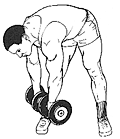 Summer vacation came to an abrupt end for many an elementary school student here in Finland today. It was my first day in the fifth grade… as a teacher. This will be my main occupation this year, but paychecks will also continue to drop in via my freelance activities including lecturing at the university and doing odd translation jobs more often than not related to city planning. The fun thing about teaching fifth graders is that you get to do the whole deal ranging from physical education to chemistry. Powerlifting is not an option in gym class, but the school does have a small gym that I will probably use now and then. Today I steered towards the regular gym.
Summer vacation came to an abrupt end for many an elementary school student here in Finland today. It was my first day in the fifth grade… as a teacher. This will be my main occupation this year, but paychecks will also continue to drop in via my freelance activities including lecturing at the university and doing odd translation jobs more often than not related to city planning. The fun thing about teaching fifth graders is that you get to do the whole deal ranging from physical education to chemistry. Powerlifting is not an option in gym class, but the school does have a small gym that I will probably use now and then. Today I steered towards the regular gym.
Did mini-band assisted GHRs as the main exercise, but did not forget to honor my dual pledge to give the midsection and calves some more time in the limelight.
Also got some inspiration from Måns’s copy of Bill Pearl’s hefty tome Keys to the Inner Universe, probably the most extensive collection of exercises there is although it gets away with only two versions of the good morning (everybody knows there are in fact 360 variations…). Compound stiff-legged dumbell deadlifts are basically a normal stiff-legged deadlift, but you don’t just bend straight down but also alternately twist down with the dumbells toward the right and left foot. Going down once to the right, middle and left counts as one rep. First tried them directly following the GHRs, but had to abort quickly as I could not bend very far to the right before pain materialized on the left side. Once the back had been warmed up by some more work they felt fine. Bending down sideways with nearly straight legs is one of the more demanding things one can subject a low back to. I figure that if I can get to a point where these are pain-free I’m pretty much good to go. In the meantime, I will start to phase deadlifts and squats back in as going straight down no longer seems to hurt.
Glute ham raise on stability ball: 9,7,5,4 @ doubled mini band assist
Front lunge, alternating: 2x10 @ 30 kg/66 lbs
Standing cable crunch, lat pulley:
15 @ 40 kg/88 lbs
3x10 @ 44 kg/97 lbs
Hanging leg raise: 4x6
Trunk twists with stick kneeling on stability ball: 3x1 minute
Upper body cable turn: 3x30 @ 30 kg/66 lbs
Compound stiff-legged dumbell deadlifts: 3x5 @ 3 kg/7 lbs
Reverse-hyper, done off hyper bench: 30
Seated calf raise: 4x10 @ 70 kg/155 lbs
Total training time: 72 min
August 13, 2004
Depleted but not deflated
It’s amazing how hectic the start of a new school year can be. If I wasn’t so excited about seeing what kind of gains would come my way on the bradford and JM press, I would have been more than happy to call it a weekend.
Progress prevailed over tiredness and Friday 13th with an excellent start on the heavier weights for both exercises. My depleted energy stores would not last a full workout, so just capped off with some rotator cuff and bicep work. Then off to the summer cottage to enjoy August.
Bradford press: 6,5,4,4 @ 52.5 kg/116 lbs
JM press: 6,5,4,3 @ 50 kg/111 lbs
Seated cable L-flye: 6,5 @ 15 kg/33 lbs
Incline hammer curl: 8,6,6,6 @ 18 kg/40 lbs
Total training time: 43 min
August 14, 2004
New articles of interest
There is a bunch of new articles up at EliteFTS.com. I found Aaron DiPrima’s article Floor Press and its Applications particularly interesting. He talks about how he began using the floor press after a pec tear to de-emphasize the reversal at the bottom of the lift (cf. suspended good mornings) and goes on to suggest that anyone could benefit from cutting back on dynamic benching.
I feel the plyometric like speed work in the touch and go style can beat up some lifters, especially those with larger pecs and longer arms. That hard ballistic bench is not a requirement for a big bench press. If you look at some of today’s top Squatters many of them do mainly box squats, which, like the floor press is a dynamic overcoming static state. If Chuck V. and Mike Ruggeria can squat over a grand not doing any ballistic squatting then why is it necessary for us to do this hard reversal on the bench press when the shoulder girdle is not nearly as stable as the hips? [..] I believe someone could develop a good bench press doing minimal bench presses as long as they do some heavy full range rep stuff after their dynamic effort and once a month on max effort.
The interview with Chuck Vogelpohl was also a great read. His thoughts on who should be using bands gave me new zeal in resisting looping my bands around a barbell sleeve.
At least be at master level of the sport and your technique needs to be dead on. Get the most out of just using bar weight and milk it; you should be able to hit some big numbers with them and chains. The bands won’t make you squat big; check between your legs before you change anything. It takes more than a band to make you squat.
A great place to be if you want to get notified about new articles is the EliteFTS.com mailing list. Of course, there will also be frequent e-mails about specials and new products, which might be annoying if you’re not a frequent customer like some of us.
August 15, 2004
Unearthing rock at Toffe’s Gym
Spent the weekend up at the summer cottage on Project Power rack. The rack itself had not been welded yet, but I had my hands full unearthing rocks of all sizes to make room for the lifting platform. The Ice Age seems to have left the soil of this particular patch of Ostrobothnian forest about 60% rock, while not neglecting to dump a big one right where I want my rack.
After I removed the soil around the huge boulder, a task made tedious by the unfortunate amount of surface roots, I realized that only about a fourth of it had been visible above ground (see the far left of the picture in this entry). After I did some futile preliminaries with an iron bar as a lever, my dad suggested we try get it up of the hole with our small winch fastened to a nearby tree. The benching chains came in handy here, but it took several attempts before we found a rope that would not snap as soon as we got the boulder going. Up it came at last. I opted to leave it quite close to the future rack as it will make a great table for my training notes and whatnot. Besides, it goes well with the general spirit of this outdoor gym.

August 17, 2004
Rolling Thunder journey begins
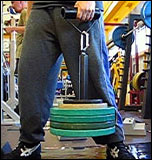 I postponed yesterday’s bench workout until today to clear up some lingering tricep soreness following Friday’s JM presses and Bradford presses. It was a wise move as the extra day of rest patched me up for another 3 rep improvement on the bench press sets. Incidentally, this was also the day I dragged yet another piece of strange equipment into the gym.
I postponed yesterday’s bench workout until today to clear up some lingering tricep soreness following Friday’s JM presses and Bradford presses. It was a wise move as the extra day of rest patched me up for another 3 rep improvement on the bench press sets. Incidentally, this was also the day I dragged yet another piece of strange equipment into the gym.
My Ironmind’s Rolling Thunder with loading pin has been waiting at the customs office since Thursday, but only now did I have time for the extensive walking required to take the declaration of the package from the mail terminal to the customs office for clearance and back. I got a good laugh at the customs when I heard that they had classified the package as ‘golf equipment’.
As I prepared to determine my Rolling Thunder max, I already knew that this is one deceptive piece of pipe. The current official world record for a single-handed deadlift using this handle plus the Ironmind 15″ loading pin is a “mere” 267 lbs/121 kg set by Estonian strongman Andrus Murumets in 2003 (here’s a picture of squat king Brent Mikesell going at it; a 192 lbs/87 kg lift gave him second place in the 2003 Northwest Rolling Thunder competition). The current women’s WR of 142 lbs/64 kg is held by none other than Becca Swanson. The sheer thickness of this handle, plus the fact that it revolves, makes this a lift a pure test of grip strength. I pyramided up in jumps of 10 kg/22 lbs and managed to get 50 kg/111 lbs off the ground with the right hand, but I had to drop down to 47.5 kg/105 lbs (VIDEO 0.5MB) to get a clean lift with both hands. Finished with some holds for time with 40 kg/88 lbs, which really drove the point home as to why a revolving handle makes this lift so much harder. Simply put, it wants to roll right out of your hand unless you hang on to it like a madman.
Bench pattern warm-up:
10 @ 20 kg/44 lbs
6 @ 40 kg/88 lbs
5 @ 50 kg/111 lbs
3 @ 60 kg/133 lbs
3 @ 70 kg/155 lbs
2 @ 80 kg/177 lbs
Heavy bench singles, paused: 3x1 @ 90 kg/199 lbs
Bench, paused: 6,6,5,5 @ 77.5 kg/171 lbs
Chest supported T-bar row: 4x6 @ 55 kg/122 lbs
Rolling Thunder: worked up to lift-off with 50 kg/111 lbs, then did 47.5 kg/105 lbs and holds for time with 40 kg/88 lbs
Captains of Crush Trainer & I gripper work
Total training time: 50 min (?)
August 18, 2004
The usual and some Rolling Thunder observations
GHRs, compound stiff-legged dumbell deadlifts… a very regular workout save for some unexpected coordination problems on the walk-outs.
After the workout I showed my newly acquired Rolling Thunder to the guy who recently embarked on a Westside program. I told him how little most people can pull with it upon which he wanted to try it himself. He pyramided up to a successful 50 kg/111 lbs lift. He defiantly gave 65 kg/144 lbs a go after I told him that he wouldn’t get it up. He had to agree that it doesn’t seem to matter that he can deadlift some 250 kg/552 lbs without straps.
While on my way back to the locker I ran into another power oriented guy I know. Couldn’t resist again unveiling the Rolling Thunder with the provocative question: “how much do you think you’d pull with this handle?”. “At least 90 kg (199 lbs)”, he responded and headed for the lifting platform. After a confident first lift at 50 kg/111 lbs he added another 20 kg/44 lbs plate. It budged, if ever so slightly. He did get 60 kg/133 lbs off the ground, but not high enough to lock it out.
Based on a survey of four male lifters (the two above, Måns’s 50 kg/111 lbs and my 47.5 kg/105 lbs) I conclude that the average lifter without thick bar training experience will probably fail at around the 55 kg/122 lbs mark give or take 5 kg/11 lbs.
Edit: This entry had corrupted comments, the problem is now fixed.
Glute ham raise on stability ball: 10,8,5,5 @ doubled mini band assist
Hyperextension: 3x12 @ 10 kg/22 lbs
Compound stiff-legged dumbell deadlifts:
10 @ 6 kg/13 lbs
6 @ 8 kg/18 lbs
10 @ 10 kg/22 lbs
Standing cable crunch, lat pulley: 2x6 @ 50 kg/111 lbs
Trunk twists with stick kneeling on stability ball: 2x1 minute
Arm and leg extension kneeling on stability ball: 2x12
Walk out with trunk twist (right and left on each rep): 7
Ab hold, one leg on floor: 2x20 seconds
Total training time: 56 min
August 20, 2004
Tipping over
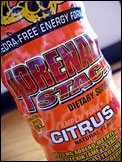 It’s been another demanding week as you can probably tell from the somewhat irregular posting schedule. A cold Adrenalyn stack (still wondering about the name) helped me remain standing for long enough to break some more records, or more specifically adding four or five reps on the Bradford press (lost count on the last set) and four reps on the JM press. Finished with some grip work highlighted by the Rolling Thunder and then went home to pass out in peace.
It’s been another demanding week as you can probably tell from the somewhat irregular posting schedule. A cold Adrenalyn stack (still wondering about the name) helped me remain standing for long enough to break some more records, or more specifically adding four or five reps on the Bradford press (lost count on the last set) and four reps on the JM press. Finished with some grip work highlighted by the Rolling Thunder and then went home to pass out in peace.
Bradford press: 6,6,6,5/6? @ 52.5 kg/116 lbs
JM press: 6,6,6,4 @ 50 kg/111 lbs
Wide-grip assisted pull-up: 6,5,4,4 @ 40 kg/88 lbs
Seated cable L-flye: 8,6 @ 15 kg/33 lbs
Incline hammer curl: 8,7,5 @ 18 kg/40 lbs
Plate curl:
1 @ 10 kg/22 lbs
2x4 @ pinch gripping 5 kg/11 lbs, 2.5 kg/6 lbs and 1.25 kg/3 lbs plate
Rolling thunder:
5 @ 30 kg/66 lbs
5 (right), 3 (left) @ 40 kg/88 lbs
Captains of Crush: 7+5 negatives, 5+5 negatives @ I
Captains of Crush holds pinching 1.25 kg/3 lbs plate @ Trainer
Total training time: 70 min
August 22, 2004
Interesting quote
We have gotten away from doing a lot of ME GM’s [maximum effort good mornings] and are now using them as heavy supplemental work. While GM’s are a great exercise, if you perform them incorrectly then you may get injured and your training will take a giant leap backwards.
Jim Wendler responding to a question over at elitefts.com
A light return to box squats and deadlifts
 The time is ripe to begin the climb back up to some real squat/deadlift workouts. Since I will be making the return very gradually, starting with ridiculously small weights, it feels natural to do both the box squats and the deadlifts as speed work on DE Squat/Dead day.
The time is ripe to begin the climb back up to some real squat/deadlift workouts. Since I will be making the return very gradually, starting with ridiculously small weights, it feels natural to do both the box squats and the deadlifts as speed work on DE Squat/Dead day.
An empty bar felt needlessly light, so worked with a safe sounding 40 kg/88 lbs on both exercises. My master plan is to increase the weight on the box squat and the deadlift with 2.5 kg/6 lbs per week. This scheme would have me increase the weight by 10 kg/22 lbs a month meaning I would be up to some meaningful speed box squat poundages by the end of the year. This timetable corresponds fairly well with my back therapist’s assessment regarding my discs being back in shape by the end of the year. I might speed things up a bit later if there are no complications, especially for the deadlift, but for now I start with this conservative base plan.
I don’t plan to do much supplementary work on DE SQ/DL day save for some ab work, but will continue doing a heavy dose of rehab work. The action will be on ME SQ/DL day where I will continue doing exercises that I can go to failure with for reps, i.e. GHRs, makeshift reverse hypers and such. Once the weights start to climb on DE day, I will slowly start to do light pin pulls etc. as supplementary work. Squats without a box will also start to figure in this context a bit later once I’ve made sure that my back can handle the reversal without locking up.
No complaints from the back today, but noticed that it had tightened up a bit when I did hanging leg raises following the box squat and deadlift. Deep down I still fear that I might have something structurally broken in my back, but at this point I cannot do much more than go on with the plan and if I get into trouble head for a magnetic scan. For now, I am glad to be back squatting and deadlifting even if it is with puny weights.
Speed box squat, 13″:
3x5 @ 20 kg/44 lbs
3x2 @ 30 kg/66 lbs
6x2 @ 40 kg/88 lbs
Speed deadlift:
2x10 @ 30 kg/66 lbs
5x2 @ 40 kg/88 lbs
Hanging leg raise: 8,7,6
Spread-eagle sit-up: 3x10
Trunk twists with stick kneeling on stability ball: 2x1 minute
Walk out with simultaneous arm and opposite leg lift: 2x12
Upper body cable turn: 2x30 @ 30 kg/66 lbs
Total training time: 55 min
August 23, 2004
One rep lost at school gym
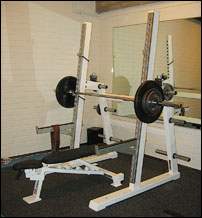 An empty slot between teaching and a meeting proved a great opportunity for a first workout at the school’s gym. Located in the basement underneath the gymnasium, it is a basic gym equipped with a half rack, two adjustable benches, a pulldown station with a 100 kg/221 lbs stack, a cable crossover station with 70 kg/155 lbs stacks, dumbells up to 21 kg/46 lbs (I think), a small leg press, a 45 degree back raise, an ab board, a rowing machine and a barbell with plates. It has a decisive dungeon feeling to it owing to the narrowness of the room, the dim lights and the somewhat stuffy air.
An empty slot between teaching and a meeting proved a great opportunity for a first workout at the school’s gym. Located in the basement underneath the gymnasium, it is a basic gym equipped with a half rack, two adjustable benches, a pulldown station with a 100 kg/221 lbs stack, a cable crossover station with 70 kg/155 lbs stacks, dumbells up to 21 kg/46 lbs (I think), a small leg press, a 45 degree back raise, an ab board, a rowing machine and a barbell with plates. It has a decisive dungeon feeling to it owing to the narrowness of the room, the dim lights and the somewhat stuffy air.
Found a cd labeled ‘Iron Maiden and Metallica’ among all the light listening and pop records. The sound system proved excellent and I made the most of it as I was the only lifter present. With Bruce Dickinson aggressively bouncing between the walls, I embarked on the standard Blakley bench day routine while trying to pretend I wasn’t hungry. Did the usual singles with 90 kg/199 lbs and then continued with the rep work. The singles went well, but ended up losing a rep over the four work sets instead of making the usual gain. Heads must roll, but not mine. This time the scapegoats are… ehem… three hours of sleep and …badly calibrated weight plates that actually weigh way more than they should… and… and… lingering soreness from the accessory day combined with my sore back. Did some one-handed rowing and then took full advantage of the iron plates to do some pinch gripping. To my surprise pinch gripping two 10 kg/22 lbs plates smooth side out was fairly easy. Progress.
Despite the initial setback, I think I might just come here from time to time to enjoy the solitude.
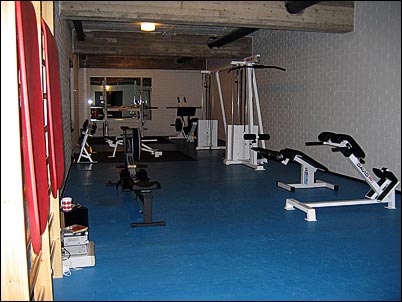
Bench pattern warm-up:
10 @ 20 kg/44 lbs
5 @ 40 kg/88 lbs
6 @ 50 kg/111 lbs
2 @ 60 kg/133 lbs
2 @ 70 kg/155 lbs
1 @ 80 kg/177 lbs
Heavy bench singles, paused: 3x1 @ 90 kg/199 lbs
Bench, paused: 6,5,5,5 @ 77.5 kg/171 lbs
One-handed standing cable side raise: 10 @ 15 kg/33 lbs
One-handed seated cable row in cable crossover: 3x10 @ 70 kg/155 lbs
Seated reverse wrist cable curl: 3x10 @ 40 kg/88 lbs
Plate pinch gripping with two 10 kg/22 lbs plates
Total training time: 59 min
August 25, 2004
Cursory pumping
Despite my good intentions, my lower back turned tender on me after the light box squat/deadlift workout. Just wanted some blood in there so concentrated on hyperextensions with a pinch of ab work, rehab exercises and calf cranking. I felt like a new man when I left the gym. Hope it lasts.
Hyperextension: 15 @ bodyweight
45 degree back raise:
10 @ bodyweight
10 @ 10 kg/22 lbs
10 @ 15 kg/33 lbs
Hyperextension:
10 @ 15 kg/33 lbs
3x10 @ 20 kg/44 lbs
10 @ 30 kg/66 lbs
Spread-eagle sit-up: 15 @ bodyweight, 3x10 @ 5 kg/11 lbs
Trunk twists with stick kneeling on stability ball: 2x1 minute
Arm and leg extension kneeling on stability ball: 2x14
Upper body cable turn: 2x30 @ 30 kg/66 lbs
Calf sled: 4x10 @ 100 kg/221 lbs
Total training time: 50 min
Westside Barbell Journal is born
As announced on the their home page, Westside Barbell Club has started its own blog, Westside Barbell Journal, with the Blogger service. The blog’s first entry, posted today, sounds promising:
Coming soon, Westside Barbell, individual club members will be sharing their training journals.
We await the new dawn… hopefully it comes with a feed.
August 27, 2004
Waiting for the train
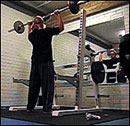 The last weekend of August is the traditional end of the summer cottage season here in Finland. Celebrated especially in Swedish speaking Ostrobothnia with bonfires, torches, fireworks and good food (often crabs), this is one festivity I rarely miss. The hour I had to spare before jumping on the northbound train with Sanna was spent in the school weight room.
The last weekend of August is the traditional end of the summer cottage season here in Finland. Celebrated especially in Swedish speaking Ostrobothnia with bonfires, torches, fireworks and good food (often crabs), this is one festivity I rarely miss. The hour I had to spare before jumping on the northbound train with Sanna was spent in the school weight room.
Made the weight increase on the Bradford press despite not being quite convinced that I indeed got 4x6 last week. I barely got six reps on the first set with 55 kg/122 lbs (VIDEO 1.8MB) before the rest of the sets came sliding down one steep hill. In contrast, it was my third week with 50 kg/111 lbs on the JM press and 4x6 came easily. I cannot be anything but satisfied considering that even a single rep at this weight was hard two months ago. Didn’t have time for more than a few quick sets of pulldowns and curls before hitting the shower.
Bradford press: 6,5,3,3 @ 55 kg/122 lbs
JM press: 6,6,6,6 @ 50 kg/111 lbs
Pulldown, close-grip: 2x10 @ 90 kg/199 lbs
Incline hammer curl: 8 @ 18.5 kg/41 lbs
Total training time: 43 min
August 31, 2004
Bummer.
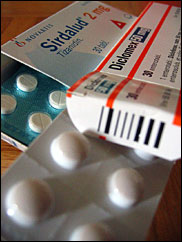 The accumulated stress of first reintroducing box squats and deadlifts and then proceeding with the normal program, including weighted hypers and Bradford presses, ended up being too much after all. I’m now twisted again as in drooping right shoulder as in lumbago.
The accumulated stress of first reintroducing box squats and deadlifts and then proceeding with the normal program, including weighted hypers and Bradford presses, ended up being too much after all. I’m now twisted again as in drooping right shoulder as in lumbago.
The Reaper came on Saturday. I had just had a refreshing swim in the dark n’ chilly August water and was standing outside watching the fireworks that, paradoxically enough, celebrated the end of the Finnish summer cottage season. Stiffness gradually turned into pain and I had to make a limping retreat inside to lay down. Next morning, the cramp was still with me. A liberal amount of pain killers made the six hour car ride back to Helsinki quite tolerable sorry mood notwithstanding.
Monday morning was much the same, but felt obliged to go to work to wrap some things up including returning the big pile of math books that I had corrected over the weekend (23 books + 1 crooked back = a lot of trouble). I ended up teaching all classes and planned the rest of the week for a possible stand-in before finally heading for the doctor. By this time, the adductors on the inside of my left thigh had also started to tighten up, possibly from all the running around.
At the doctor’s I knew the drill. Tell story, have knees and ankles hammered, bend over and confirm that you can feel your feet. On the bending over part I surprised both myself and the doctor with almost being able to touch the floor despite the cramp. I also knew what I would get, i.e. a prescription for tizanidine and diclofenac to deal with the cramp and some sick leave (rest of the week) to prevent me from doing any more potentially hazardous math equations. I asked the doctor’s opinion on taking a MRI scan of my back. She said that since everything, luckily, points to a muscle condition and not a disc condition this would amount to a waste of my money. She also expressed high regard for the expertise at the back clinic and continued that relapses are quite common when dealing with something as complex as a back injury. After the appointment I went to the bookstore to pick up another Vonnegut, this time Palm Sunday, and then headed for the pharmacy. The adductors were starting to make life difficult for me and I was thankful the bus had been invented. Home.
This morning I was straight again, but as I prepared my breakfast the back cramp kicked back in. The adductors also keep defying the muscle relaxants by going into a painful cramp whenever I stand or walk for more than a minute. Can’t even do the banana, but interestingly enough I don’t really feel that I need it. The back is no longer painful, but the adductors are.
Adductors, adductors. Why would they cramp? Somewhat grudgingly I have to admit that for some time I haven’t been able to sit down on the floor and open my legs more than 90 degrees. I remember the days when I could spread them out a full 180 and then put my chest on the floor. Tightness is definitively a prime suspect. And what am I going to do about that? Stretch, stretch.
I found an interesting article by Chris Mallac that discusses how overuse of the adductor magnus may lead to trigger point development within the muscle. His first case study deals with a powerlifter with a six-month history of left-sided lower back pain. The patient had, like me, also done exercises for the core stabilizers and had also had cortisone injections to no avail. A month after trigger point massage of the adductors began this lifter was back on track on both the deadlift and the squat. It is interesting to read that the author has found the large majority of adductor magnus problems to be left-sided, which would also be true in my case if it turns out I have trigger points there.
All in all, I don’t think this relapse really necessitates a fundamental rethinking of my rehab approach. The increased mobility and lower amount of stiffness is a sign that progress has taken place, but I definitively need to reconsider my squat and deadlift schedule. I also need to take stretching more seriously and liberate my legs. Two steps forward, one step back, I suppose. Good thing I can bench.